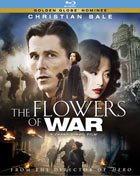BLU-RAY REVIEW

Flowers Of War, The
Featured In Issue 168, July/August 2012
The Flowers Of War takes place in 1937, when Nanjing City stands at the forefront of a war between China and Japan. As the invading Japanese Imperial Army overruns China's capital city, desperate civilians seek refuge behind the nominally protective walls of a western cathedral. Here John Miller (Bale), an American trapped amidst the chaos of battle and the ensuing occupation, takes shelter, joined by a group of innocent schoolgirls and 13 courtesans, equally determined to escape the horrors taking place outside the church walls. Struggling to survive the violence and persecution wrought by the Japanese army, it is an act of heroism, which eventually leads the seemingly disparate group to fight back, risking their lives for the sake of everyone. Based on the novel by Yan Geling. (Gary Reber)
Special features include a five-part making-of documentary (HD 93:48), the trailer, and up-front previews.
The 1080p AVC picture is cinematic throughout, but with inconsistent rendering, with varying contrast and stylization effects. Color fidelity shifts from perfectly natural to a yellowish- and greenish-filtered overlaid. As such, at times fleshtones appear perfectly natural or off tone. Perhaps the intended look was to characterize the 30's period, but the effect is present throughout and disorienting. Blacks are deep and solid, and shadow delineation is revealing. Resolution is generally revealing as well, but soft overall. While the appearance varies, the overall sense is of a cinematic scope and is visually engaging. (Gary Reber)
The DTS-HD Master Audio™ 7.1-channel soundtrack is holosonic® and enveloping throughout, with an almost constant atmospheric background of battle and warfare. When the battles occupy the scene, the atmospherics and sound effects are effectively dynamic and aggressively directionalized. Low-level sounds are nicely resolved and spatially engaging. Dialogue is nicely defined, with a combination of Mandarin and English that sounds generally integrated spatially. The music score is nicely recorded with a violin soloist lead, and at times choral voicings spanning the soundstage. Deep .1 LFE bass is appropriately used to heighten the battle scenes, resulting in intensifying the sense of combat. The soundtrack adheres to the Dolby® theatrical standard with the added two channels to the back. This is problematic for systems in which the surrounds in a 5.1-channel presentation are already positioned toward the back and not at 90 degrees relative to the primary listening position. Thus, with loudspeakers added to the 90-degree position requires some rewiring to allocate channels appropriately to adhere to the Dolby theatrical standard. The full-channel allocation is effectively used throughout to create an expansive soundfield sonic experience. This is an impressively executed soundtrack that sounds dynamic and dimensional, which effectively supports the epic storytelling. (Gary Reber)

 then "Add to Home Screen"
then "Add to Home Screen"